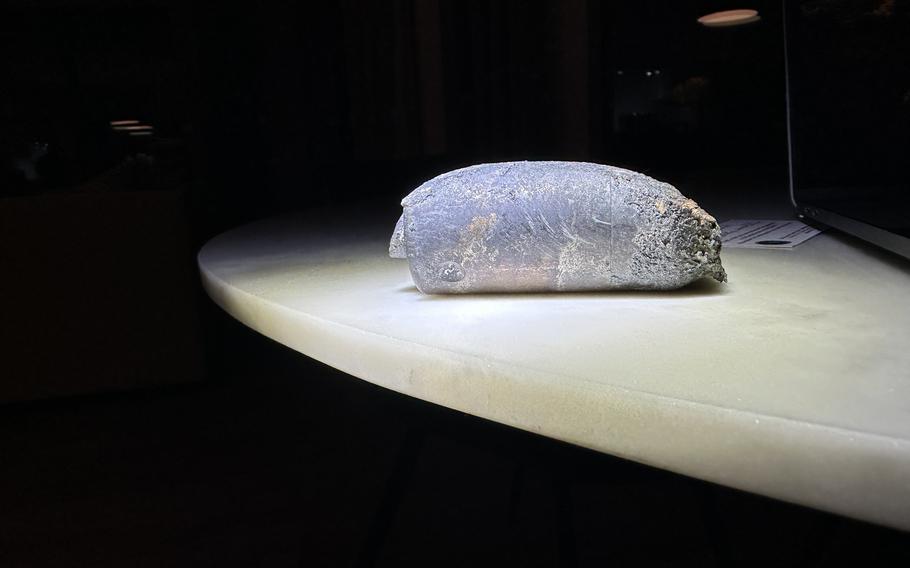
The metal debris that fell through Alejandro Otero’s roof on March 8, prompting speculation that it had tumbled from the International Space Station. (Alejandro Otero)
Alejandro Otero was traveling overseas when he received a panicked call from his son back home.
“He goes, ‘Dad, are you guys sitting down?’ ” Otero recalled.
An object tumbling from the sky had struck Otero’s Naples, Fla., house with a bang that startled his son. Otero cut his trip short and returned home to find a hole torn through his roof and second-story floor. The bewildered father searched for the culprit and found an unusual projectile — a dense, cylindrical piece of charred metal a little smaller than a soup can — lodged in a wall.
It didn’t look like a normal piece of debris to Otero. He insisted: “I knew it was from outer space.”
Otero’s theory might not be far off. He learned after searching online that a pallet of old batteries jettisoned from the International Space Station in 2021 had been expected to reenter Earth’s atmosphere on March 8, the day his house was struck. He connected with astrophysicists on social media, and together they wondered: Had his house been hit by a garbage disposal from orbit, several years in the making?
It was compelling enough to warrant NASA’s attention, Otero said. Investigators from the agency came to his house last week to retrieve the metal cylinder and determine whether it came from the ISS.
“It’s unreal,” Otero said.
NASA did not immediately respond to a request for comment Wednesday afternoon. Agency spokesperson Josh Finch confirmed to Ars Technica that NASA retrieved the object and that engineers at Florida’s Kennedy Space Center are analyzing it to determine its origin.
If the debris did come from the ISS, Otero may have just been the victim of astronomically bad luck. It’s common for NASA to toss its trash into space, where it is usually vaporized upon reentering Earth’s atmosphere, Jonathan McDowell, an astrophysicist at the Harvard-Smithsonian Center for Astrophysics, wrote in an email.
But the load of space garbage whose reentry coincided with Otero’s house being struck was particularly noteworthy. The haul — a 2.9-ton pallet of old nickel-hydrogen batteries — was the heaviest object ever jettisoned from the ISS when it was flung into space in March 2021, Gizmodo reported.
NASA had intended to load the old batteries in an unmanned cargo spacecraft for disposal, but a failed Soyuz rocket launch in 2018 snarled the schedule of spacewalks and departures from the ISS and forced astronauts to release the pallet into space on its own, according to Gizmodo.
That pallet was expected to orbit Earth harmlessly for several years before burning up in the atmosphere, according to a NASA news release from 2021. The U.S. Space Force tracked the pallet as it orbited the planet over the next few years, McDowell said. In early March, McDowell tweeted that the pallet was predicted to reenter Earth’s atmosphere around March 8 — and that some pieces of debris might survive reentry. Germany’s Federal Office for Civil Protection and Disaster Relief issued a warning about the incoming debris, according to Space.com.
Otero’s son wasn’t hurt when the metal object struck his home, Otero said. Otero was compelled to investigate the source of the mystery projectile. He conversed with McDowell on social media and eventually connected with NASA. Agency representatives visited his house last Thursday to retrieve the metal object, he said.
McDowell said he thinks there’s a good chance the projectile that struck Otero’s home did originate from the ISS, based on tracking of the space junk’s descent, he said.
“Debris was probably scattered over a few hundred miles … from mid-Gulf to Florida,” McDowell said. “I think it very likely that [Otero’s] object is indeed from the pallet.”
After the investigation, Otero would like to keep his cosmic souvenir — “I asked for that 100 times,” he said. Otero said that while NASA’s representatives were “shocked” and “apologetic” about his experience, they told him that they first needed to confirm that the debris was in fact the agency’s property. They did not confirm whether they would return the object to Otero, he said.
“I’d love to keep it for all kinds of reasons, but I’m not holding my breath,” Otero said.
As NASA investigates, Otero is also working to fix his house. He has contacted his insurance company about repairing his roof.
“I went on the website and filed the claim and had to click on what kind of damage it was,” Otero said. There was no option that matched. “… I clicked ‘other.’ ”